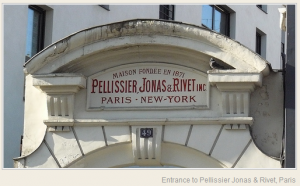 I came across the arch above on one of my Parisian wanders. It’s the entrance to a factory that no longer exists at 49 Rue de Bagnolet, near Père Lachaise. It attracted my attention because it is a rather lovely portico and because of the fact that I have no idea what the factory behind it would have looked like.
I came across the arch above on one of my Parisian wanders. It’s the entrance to a factory that no longer exists at 49 Rue de Bagnolet, near Père Lachaise. It attracted my attention because it is a rather lovely portico and because of the fact that I have no idea what the factory behind it would have looked like.
The first reference I could find for the company Pellissier Jonas & Rivet was on a patents website for a fur carroting process, which, as you can see in the pdf in the previous link refers to a way of treating animal fibres so that felt-like properties are imparted to them.
Fur carroting before this time used mercury, which of course caused major problems for the workers using it. As I’m sure you know, the phrase “mad as a hatter” comes from the behavioural changes caused by mercury poisoning.
Jonas & Rivet’s new process made use of a selection of acids instead (presumably better for the workers (?)) . The company is described as being an American hat making company.
Pellissier refers to the occupation of fur garment maker, so we can deduce from that they were either manufacturers of the felt for the hats or the hats themselves. They had branches in the US and France, as indicated in the picture at the top of the page.
Felt hat from early twentieth century
In a Tariff Hearings document presented to the US Congress House Committee in 1908 the company appears in the name of Pellissier, Jeunes Rivet, Brooklyn, NY, so we can guess that they had a factory or head office in that neighbourhood and can only wonder why Jonas isn’t there. Or perhaps Jeunes is just a misprint or mishearing of Jonas.
Louis August Jonas was the Jonas of the firm and he made sufficient money that his son, George E Jonas, founded the Louis August Jonas Foundation in America. It provides opportunities for young people. He also founded Camp Rising Sun in Red Hook, New York. George (aka Freddie) was also a partner in the felt manufacturing firm for a time.
In 1953 a report appears in the Kingston Daily Freeman newspaper that the company’s plant in Walden, NY is up for sale, so they obviously had at least one other plant in the States, and I wonder if it was around then that the company wound up? And I wonder when the Paris workshop closed? And who was Rivet? I haven’t been able to find anything on him yet.
So what’s the point of this post? Simply that curiosity and noticing things are what keeps travelling and wandering the fascinating occupations that they are. The fact that the portico is still there means that someone somewhere decided it was important or attractive enough to keep it, even as the area around it developed. There are still traces of the past to be uncovered and isn’t it interesting to try to do that?

Born in Belfast and now living in London, Julie McNamee is involved in internet marketing as a day job and blogging as a hobby. She’s interested in all things quirky and Fortean, as well as art, photography and theatre. Her blog Quirky Travel, specializes in London and Paris top tips and off the beaten path information with subjects such as London film locations and unusual Paris museums.









